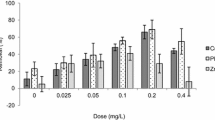Abstract
Employing a combination of two types of polyelectrolyte might become necessary to enhance both the settling rate of the flocs and the water clarity of a fine-particle suspension in a high-capacity thickening process. The sequence of addition, mixing, type and dosage of polymer all affect the overall performance and capacity of a thickening process. For the sedimentation of copper flotation tailings, the cylinder test results showed that two different techniques may be used to achieve the required performance, i.e., a high settling rate of the flocs and the deisired underflow density and overflow water clarity. The required performance can be acheived by either adjusting the pH prior to anionic polyelectrolyte flocculation or using a combination of polymer flocculant and coagulant (dual-polymer system). The dynamic thickening test results showed that only the approach using a dual-polymer system is capable of meeting the required performance. The effects of polyelectrolyte dosage, the sequence and numbers of polyelectrolyte addition, the feed concentration, the bed level and the rake speed on the settling rate, underflow percent solids and water clarity were studied in cylinder tests and in a laboratory dynamic thickening unit. The dynamic test is especially valuable in evaluating the addition and mixing of polymers. The results were evaluated quantitatively using total suspended solids in supernatant, underflow density and capacity per unit of settling area per unit of time. The objective of this study was to quantify and explain some of the parameters involved in the sedimentation of copper flotation tailings.
Similar content being viewed by others
References
Attia, Y.A., 1992, “Flocculation,” Chapter 9, Colloid Chemistry in Mineral Processing, Elsevier Science, New York, NY., pp. 277–308.
Emmett, R.C. and Klepper, R.P., 1980, “Technology and performance of the hi-capacity thickener,” Mining Engineering, August, pp. 1264–1269.
Farrow, J.B. and Swift, J.D., 1991, “Improving thickener technology,” Proceedings of the Extractive Metallurgy Conference, Perth, Australia, Oct., 2–4, pp. 227–232.
Fitch, B., 1993, “Thickening theories — An analysis,” AIChE Journal, Vol. 39, No. 1, pp. 27–36.
Foshee, W.C., Swan, M.J., and Klimpel, R.R., 1982, “Improvement in coal preparation-water clarification through polymer flocculation,” Mining Engineering, March, 1982, pp. 293–297.
Ghalambor, A., Foreman, W.E., and Hayatdavoudi, A., 1990, “Optimization of thickener performance,” Minerals and Metallurgical Processing., Nov., pp. 189–197.
Hogg, R., Bunnaul, P., and Suharyono, H., 1993, “Chemical and physical variables in polymer- induced flocculation,” Mineral and Metallurgical Processing, May 1993, pp. 81–85.
Keleghan, W. and Emmermann, D.K., 1985, “Clarifying and thickening with the HCT-process, The route to lower costs and improved performance,” Autbereitungs-Technik, Vol. 26, No. 2, February, pp. 77–85.
Peng, F.F., and Di, P.K., 1994, “Effect of multivalent salts-calcium and aluminum on the flocculation of kaolin suspension with anionic polyacrylamide,” J. Colloid & Interface Sci., Vol. 164, pp. 229–237.
Petaja, T., 1980, “Fundamental mechanisms of retention agents, Part II, Dual polymer systems,” KemiaKemi, Vol. 7, No. 5, pp. 261–263.
Ringqvist, L., and Igsell, P., 1994, “Dual polymer system in peat dewatering,” Energy & Fuels, Vol. 8, pp. 953–959.
Shannon, P.T., and Tory, E.M., 1966, “The analysis of continuous thickening,” Transactions, Society of Mining Engineers, Vol. 235, pp. 375–382.
Author information
Authors and Affiliations
Additional information
Preprint 97-177, presented at the SME Annual Meeting, Feb. 24–27, 1997, Denver, CO. Discussion of this peer-reviewed and approved paper is invited and must be submitted to SME prior to may 31, 1998.
Rights and permissions
About this article
Cite this article
Peng, F.F., Lu, Z. Polymer flocculation and coagulation for sedimentation of copper flotation tailings. Mining, Metallurgy & Exploration 15, 14–20 (1998). https://doi.org/10.1007/BF03402781
Published:
Issue Date:
DOI: https://doi.org/10.1007/BF03402781




